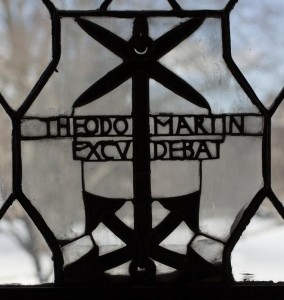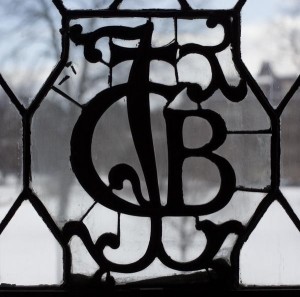Posted on behalf of Katherine Durr, 2013 Vassar Ford Scholar
Over the summer, I worked as a Ford Scholar on a project entitled The Mark of the Renaissance Printer: Developing a Digital Humanities Project on Printers’ Marks in the Windows of the Vassar College Library with Professor Ronald Patkus, Director of Archives and Special Collections. The focus of this project began with the arched windows in the north and south wings of the Thompson Memorial Library, as well as the large, central window in the Class of 1951 Reading Room. Each of these windows contains one or many printer’s marks – symbols and monograms developed by European printers, publishers, and booksellers during the 15th and 16th centuries. Eighty-two of these marks were installed in the original library, however, due to renovations, only sixty-six remain today. They represent printers from nine geographical regions throughout Europe. Prior to beginning my research, the only available information regarding these windows was contained in a now outdated pamphlet published by Vassar librarians in 1917. This document featured the names of the printers, their years of activity, and images of their marks, but did not include biographical information, historical context, and explanations of the marks themselves, information that library visitors often are curious about.
My central goal was to compile biographies for each printer, charting their innovations in the art of printing, as well as taking into account their cultural involvements – both religious and political. I also compiled descriptions of the printers’ marks. Because many of these printers were active during the years of the Protestant Reformation, much of my research revealed significant developments and lines of influence among those involved with the publication of both sacred and secular texts. For example, printers who generally published Christian works – usually Bibles, the literary works of saints, and papal documents – often included elements of Christian symbolism in their marks and printing devices. Whereas those involved in the publication of popular humanist texts adopted more personal emblems, frequently including Classical and commercial motifs. In addition to demonstrating greater historical involvements, the marks and monograms of printers indicate patterns of stylistic influence, clear within circles of printing presses, publishing houses, and very often, families. Most marks underwent several stages of evolution and variation throughout decades – even centuries – of activity. Accordingly, my initial focus opened up from a study of Vassar’s own history into a tracing of both the development of printing and its lines of visual and cultural transmission.
After writing these biographies and visual analyses of the marks themselves and compiling corresponding bibliography, I published my entries to a website within Vassar’s Digital Library. In my efforts to enhance Vassar’s digital archives and to preserve our own visual and historical artifacts, I also hope to contribute to a larger area of research and scholarship, known as the digital humanities. This growing field explores the benefits of transferring materials and resources into more organized, widely available domains.




Any idea what stained glass studio designed and built the printers’ marks windows in the library? Any info would be nice to have, Thanks! ZG